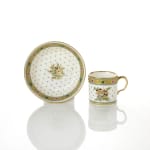Sèvres Porcelain
H.1 3/8 Dia.3 1/8in
Further images
Literature
Both parts with gilded factory mark. The cup with the gilder’s mark # for Michel-Barnabé Chauvaux, known as Chauvaux l’aîné or Chauvaux père (active at Vincennes and Sèvres 1752-88). The saucer also with the gilder’s mark B for Jean-Pierre Boulanger (active at Vincennes and Sèvres 1754-85). These gilders carried out the flat gilding of the rims, base lines and handle.
Jewelling on white ground pieces is uncommon at Sèvres. We know a few examples, including pieces with jewelled dolphins, which may be dated to late 1781-1782, as they celebrate the birth of the Dauphin.
There is a closely-related cup and saucer of this size in the State Hermitage Museum, St. Petersburg. It also has the gilder’s mark for Boulanger and the same pattern of gilded dots around the cup and in the well with the same ‘jewelled’ sprays of flowers. The border pattern on the cup and saucer in the Hermitage is of a lighter pattern than on the present example.
Invoices from 1780 Coteau to the Sèvres manufactory survive for his creation of steel dies cut with patterns in which gold foils, such as those found on this piece, were to be stamped. They were applied to the porcelain and fired with translucent or opaque enamels such as the dolphins and ‘pearls’ on this cup and saucer. The apogee of this work was the ‘jewelled’ toiled service presented in 1782 by Louis XVI & Marie-Antoinette to Catherine the Great of Russia’s daughter-in-law Maria-Fedorovna. This and other pieces made at the same time survive in their original home the Palace of Pavlovsk outside St. Petersburg. Other pieces from the same provenance (some in fact purchased by the Grand Duchess and her husband, not solely given to them) are also in the State Hermitage, St. Petersburg.
One Sèvres Vase in the State Hermitage even bears Coteau’s signature which is unbelievably rare to find. It also is overlaid with the same patterns of gold dots and the same border band is found on the neck and below the bowl on the stem. It bears the date letters for 1782.
The process of ‘jewelling’ on Sèvres porcelain is seen on lavish pieces, as it was indeed hugely expensive, made from 1779 for a small number of years to 1787. There is much reference to this process in various publications of the last 20 years. Philippe Parpette, a full-time painter at Sèvres, and Joseph Coteau who was not an employee of the manufactory appear to have been the main artists involved in the various pieces of this type. Their work is chiefly not indicated by marks whilst some pieces have the mark of a painter of a reserved area and often the mark of a gilder is present for the artists responsible for the flat-gilded rims and border patterns. In 1782 Coteau tried to be appointed as the only artist to carry out this work, but the Director of the manufactory thought that competition was important.
Private Collection, Japan, 2024





